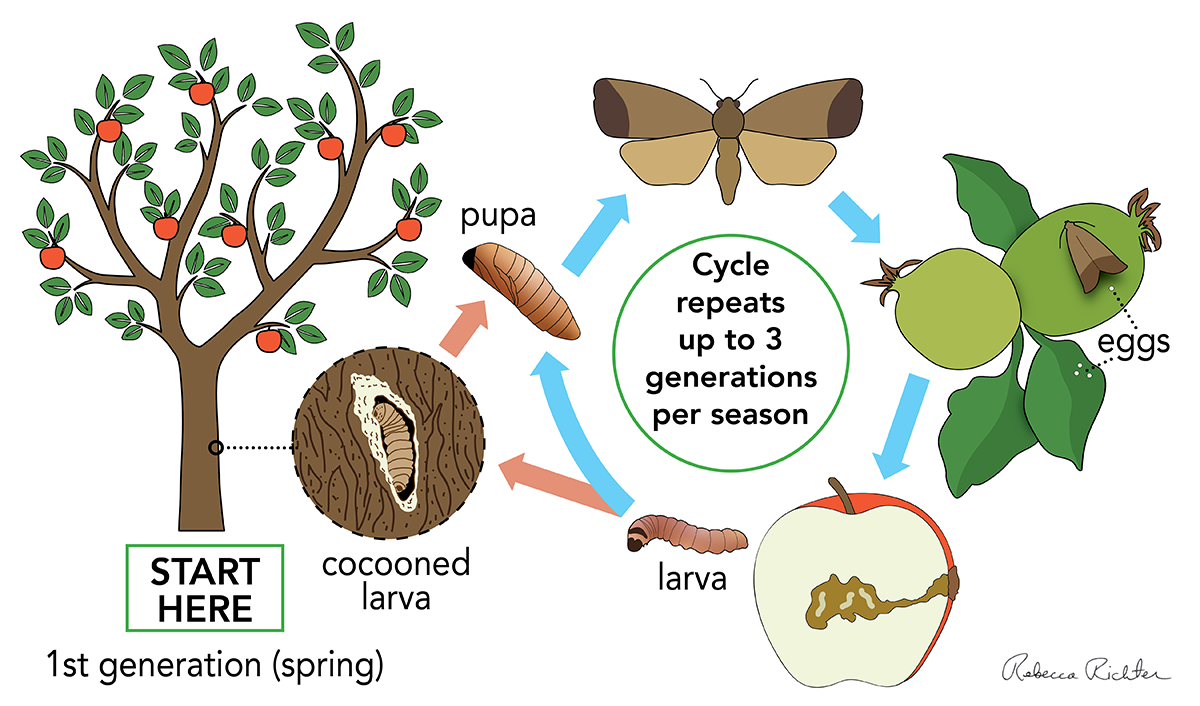Codling Moth Woes - How to Keep Worms Out of Your Apples

The Problem with Worms in Apples

There's nothing worse than biting into a crunchy, juicy apple only to find a worm making itself at home inside. It's a frustrating experience, especially when you're looking forward to enjoying a fresh, healthy snack.
Worms in apples are typically the larvae of codling moths or apple maggots. These pests can cause significant damage to apple and pear trees, reducing fruit quality and yield. The damage isn't just limited to the fruit itself; the trees can also be affected, leading to a decrease in overall productivity.
The Scale of the Problem
If left uncontrolled, codling moths can infest a staggering 20-90% of the fruit. Imagine harvesting a batch of apples, only to find that most of them are ruined. The economic impact on commercial growers can be substantial, but even for home gardeners, it's disheartening to see their hard work go to waste.
The issue is widespread, affecting apple and pear trees across various regions. Some common signs of infestation include:
- Holes or tunnels in the fruit
- Discoloration or softening of the fruit
- Presence of frass (insect waste) near the entry points
Understanding the problem is the first step towards finding a solution. By recognizing the signs of infestation and taking proactive measures, you can protect your trees and enjoy a healthier harvest.
Identifying Codling Moths
Imagine biting into a crunchy, juicy apple, only to find a worm making itself right at home. Yeah, it's a real appetite killer. Codling moths are the culprits behind these pesky worms, and knowing how to identify them is key to keeping your apples worm-free.
What Do Codling Moths Look Like?
Codling moths aren't exactly the most glamorous creatures. They're gray with mottled gray wings, and if you look closely, you'll notice copper lines on the tips of their wings. They're pretty small, too - about 1/2 inch long. Don't worry if you're not an expert; these moths are pretty easy to spot if you know what you're looking for.
The Larvae: The Real Culprits
The larvae are where the real damage happens. These white to light pink "worms" can grow up to 3/4 inch long and have distinctive dark brown heads. They're the ones burrowing into your apples, leaving behind trails of frass (that's insect poop, for the uninitiated). It's not exactly pleasant, but understanding what you're up against is crucial for effective management.
Here's the thing: codling moths go through a life cycle that's pretty fascinating if you're into that sort of thing. They start as eggs laid on apple leaves or fruit, hatch into larvae that burrow into the apples, and then emerge as adult moths to start the cycle all over again. Knowing this cycle can help you time your pest control efforts for maximum impact.
For example, if you can catch the moths before they lay eggs, you can prevent the larvae from ever getting started. It's all about timing and being proactive. Some gardeners even use sticky traps to capture the adult moths before they can cause any damage.
Life Cycle of Codling Moths

Those pesky codling moths - they're like the ninjas of the orchard, sneaking in and ruining your apples before you even know they're there! But understanding their life cycle is key to keeping them under control.
Winter Hideouts
Codling moths spend the winter months as caterpillars, snuggled up in cocoons under loose bark or debris. It's like they're waiting for the perfect moment to strike. And strike they do - as soon as the weather warms up, they're off and running.
Emergence and Egg-Laying
In most regions, adult codling moths emerge in April or May, when the apple blossoms are falling off. That's when the females start laying eggs on leaves and small fruit. They can lay up to 50-60 eggs in their lifetime, which doesn't sound like a lot, but trust me, it's enough to ruin your apple harvest.
Larval Stage
The larvae feed on the fruit for about three weeks, leaving behind a trail of frass (that's insect-speak for poop) and damage. After they've had their fill, they tunnel out of the apple and pupate, starting the cycle all over again. It's a never-ending battle, but knowing what you're up against is half the battle.
For example, if you live in an area with a warm climate, you might see multiple generations of codling moths in a single growing season. In cooler climates, you might only see one or two. Either way, knowing when to expect them is crucial to keeping your apples worm-free.
Managing Codling Moth Infestations
Imagine biting into a crunchy, juicy apple, only to find a worm making itself right at home. Yeah, codling moths can ruin the party. But don't worry, managing these pesky critters is easier than you think.
First things first, you need to know when the moths are active. That's where codling moth traps and pheromone lures come in. These sticky traps attract male moths, giving you an idea of when the moths are flying and mating. You can place these traps in your orchard or even in a single tree when the trees are in bloom, typically around late April or early May. By monitoring the traps regularly, you'll know exactly when to take action.
Controlling the Infestation
Once you've detected moth activity, it's time to control the larvae population. You can use pesticide sprays or biological controls like horticultural oil. These oils work by suffocating the larvae, preventing them from causing further damage. For best results, apply these controls when the larvae are still young, usually around 3-4 weeks after the first moths are detected.
Some specific options to consider include:
- Spinosad, a natural insecticide derived from soil bacteria
- Kaolin clay, which repels moths and larvae
- Parasitic wasps, a biological control that targets codling moth larvae
Regular Inspections are Key
Regularly inspecting your apples is crucial in detecting infestations early. Look for signs like unusual holes, discoloration, or sticky substances on the fruit. If you catch the infestation early, you can remove the affected apples and prevent further damage.
Preventing Future Infestations

So, you've managed to keep those pesky codling moths at bay this season, but don't get too comfortable – a solid plan is key to keeping them from coming back. Maintaining your apple trees properly is a great place to start. Regular pruning and sanitation can go a long way in preventing future infestations. Remove any infested fruit, and dispose of it far away from your trees. This will help reduce the number of codling moths in your area.
A Multi-Pronged Approach
Don't rely on just one method to keep codling moths under control. Instead, use a combination of traps, sprays, and biological controls to keep them at bay. For example, sticky traps can capture adult moths, while sprays containing spinosad or kaolin clay can help control larvae populations. You can also introduce natural predators, like Trichogramma wasps, which parasitize codling moth eggs.
Weather Watch
Codling moths thrive in warmer climates, which can lead to multiple generations per year. In areas with mild winters, you might see up to four generations of codling moths in a single year. Keep an eye on the weather forecast and adjust your control methods accordingly. If you're in a region with a long growing season, be prepared to monitor your trees regularly and apply controls as needed.
Some specific things to keep an eye on include:
- Temperature: Warmer temperatures can accelerate codling moth development
- Moisture: High humidity can increase the risk of infestation
- Tree health: Stressed trees are more susceptible to infestation












Comments ()